One of the stages in the construction of a private house is the design and creation of a heating system. This is a difficult stage, since you need not only to design heating, but also to save on materials. An important factor is the fact that the created heating should be distinguished by efficiency and economy. We create heating a private house with our own hands - you can find the wiring diagrams (the most basic) in our review.
There are many schemes for distributing heating pipes for private households. Some of them are combined, which makes it possible to increase the efficiency of the system and achieve a more even heating of the whole house. In our review, we will consider only the most basic schemes:
- one-pipe horizontal scheme;
- one-pipe vertical scheme;
- scheme "Leningradka";
- two-pipe system with bottom wiring;
- two-pipe system with top routing;
- beam system with collectors;
- schemes with forced and natural circulation.
Let's look at the features of the presented schemes, as well as discuss their advantages, disadvantages and installation features.
One-pipe systems
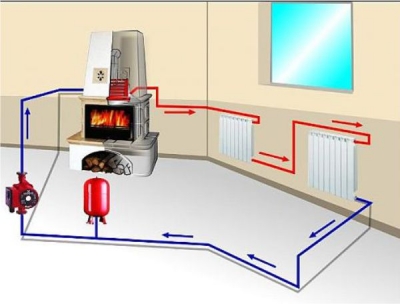
In one-pipe heating systems, the coolant passes sequentially through all radiators.
When creating heating a private house with your own hands, the easiest way is to equip a one-pipe heating system. It has many advantages, such as economical use of materials. Here we can save good money on pipes and achieve heat delivery to each room. A single-pipe heating system provides for the sequential delivery of the coolant to each battery. That is the coolant leaves the boiler, enters one battery, then another, then a third, and so on.
What's going on in the last battery? Having reached the end of the heating system, the coolant unfolds and is sent back to the boiler through a solid pipe. What are the main advantages of such a scheme?
- Ease of installation - you need to consistently pass the coolant through the batteries and return it back.
- The minimum consumption of materials is the simplest and cheapest scheme.
- Low location of heating pipes - they can be mounted at the floor level or completely lowered under the floors (this can increase the hydraulic resistance and require the use of a circulation pump).
There are also some disadvantages that you have to put up with:
- limited length of the horizontal section - no more than 30 meters;
- the farther from the boiler, the colder the radiators.
However, there are some technical tricks that allow you to level these shortcomings. For example, the length of the horizontal sections can be handled by installing a circulation pump. It will also help make the latest radiators warmer. Bypass jumpers on each of the radiators will also help to compensate for the drop in temperature. Let's now discuss the individual varieties of one-pipe systems.
Single pipe horizontal
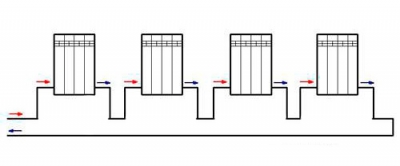
The simplest version of a one-pipe horizontal heating system with bottom connection.
When creating a heating system for a private house with your own hands, a single-pipe wiring scheme may be the most profitable and cheapest. It is equally well suited for both one-story houses and two-story houses. In the case of a one-story house, it looks very simple - radiators are connected in series - in order to ensure a consistent flow of the coolant... After the last radiator, the coolant is sent through a one-piece return pipe to the boiler.
Advantages and disadvantages of the scheme
To begin with, we will consider the main advantages of the circuit:
- ease of implementation;
- great option for small houses;
- saving materials.

A single-pipe horizontal heating scheme is an excellent option for small rooms with a minimum number of rooms.
The scheme is really very simple and straightforward, so even a beginner can cope with its implementation. It provides for a serial connection of all installed radiators. it ideal heating wiring diagram for a small private house... For example, if it is a one-room or two-room house, then it does not make much sense to "fence" a more complex two-pipe system.
Looking at the photo of such a circuit, we can note that the return pipe is one-piece here, it does not go through the radiators. Therefore, such a scheme is more economical in terms of material consumption. If you do not have extra money, such a layout will be the most optimal for you - it will save money and allow you to provide the house with heat.
As for the shortcomings, there are few of them. The main disadvantage is that the last battery in the house will be colder than the very first one. This is due to the sequential passage of the coolant through the batteries, where it gives off the accumulated heat to the atmosphere. Another disadvantage of a one-pipe horizontal circuit is that if one battery fails, the entire system will have to be turned off at once.
Despite certain disadvantages, such a heating scheme continues to be used in many small private houses.
Features of installation of a single-pipe horizontal system
Creating water heating for a private house with your own hands, a single-pipe horizontal wiring scheme will be the easiest to implement. During the installation process, it is necessary to mount the heating batteries, and then connect them with pipe sections. After connecting the very last radiator, it is necessary to turn the system in the opposite direction - it is desirable that the outlet pipe runs along the opposite wall.
The larger your home, the more windows it has and the more radiators it has. Accordingly, heat losses also grow, as a result of which it becomes noticeably cooler in the last rooms. You can compensate for the drop in temperature by increasing the number of sections on the last radiators... But it is best to mount a system with bypasses or with forced circulation of the coolant - we will talk about this a little later.
A similar heating scheme can be used to heat two-story houses. For this, two chains of radiators are created (on the first and second floors), which are connected in parallel to each other. There is only one return pipe in this battery connection diagram; it starts from the last radiator on the first floor. A return pipe descending from the second floor is also connected there.
Single pipe vertical
How else can you heat two-story households with a one-pipe system? There really is an alternative - this is a one-pipe vertical heating system, which is used by many people looking for a suitable steam heating scheme in a private house. There are no difficulties in such a scheme, you just need to bring the supply pipe with the coolant to the second floor and connect the batteries located there, and then make bends down to the first floor.
Advantages and disadvantages of a single-pipe vertical scheme
As usual, let's start with the positives:

In one-pipe vertical heating systems, the heating medium flows from the radiator on the upper floor to the lower floors.
- more pronounced savings on materials;
- comparatively the same air temperature on the first and second floors;
- ease of implementation.
The list of disadvantages is the same as in the previous scheme. It includes heat losses on the last radiators. And since the coolant is supplied through the upper floor, then it may be cooler on the first floor than on the second.
The savings on materials are more than solid. Upstairs we send only one pipe, from which the coolant is distributed over all radiators of the second floor (not sequentially). From each upper radiator, the pipes go down to the radiators on the ground floor, after which they fall into one common return pipe. Thus, this scheme assumes minimal use of materials.
Features of installation of a single-pipe vertical system
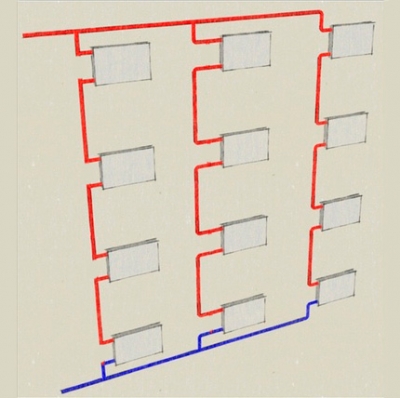
When installing a vertical one-pipe system, you will receive as many chains as there are radiators on each floor.
In the previous scheme of gas heating in a private house, pipes sequentially bypassed the radiators on the first and second floors. That is, we have two parallel chains were obtained, in each of which several radiators were turned on... In the current diagram, we also have chains, but they are vertical. For example, if there are four radiators on each floor, then we get four chains connected in parallel.
This scheme assumes one solid supply pipe running along the upper floor. Taps are made from it to each radiator. After passing through the upper radiators, the coolant enters the lower radiators, only after that - into the return pipe passing through the first floor.
If in the first case the greatest heat losses were observed in the distant radiators of the first and second floors, then in this scheme it will be cooler on the first floor, since part of the heat will be consumed on the second floor.
A single-pipe vertical heating scheme of a private house with a gas boiler can be implemented without forced circulation of the coolant. The thing is that the temperature of the coolant supplied to the radiators of the second floor is the same. The temperature drop is observed only on the ground floor. But if we supplement the radiators with bypass jumpers, then the temperature change will be minimal - it can be neglected.
Thus, this scheme, supplemented by bypass jumpers, will be the most economical and inexpensive among any other schemes. Any other boiler can be used instead of a gas boiler. The electric heating scheme of a private house is no different from gas heating (except for the type of boiler).
Scheme "Leningradka"

The Leningradka heating system is an improved one-pipe system.
Both schemes considered have one common drawback - a drop in temperature in the last heatsinks. In the case of a horizontal circuit, we have cold radiators in horizontal chains, and in the case of a vertical circuit, in vertical chains. That is, in the latter case, it is the whole first floor.
The heating scheme "Leningradka" in a private house allows you to compensate for the cooling of the coolant during the passage of the next radiator. How is it implemented? This scheme provides bypass jumpers located under the batteries. What do they give? Jumpers allow you to direct part of the coolant bypassing the radiators, therefore, the coolant at the outlet is as warm as at the inlet (minor deviations can be neglected).
Advantages and disadvantages of the "Leningradka" scheme
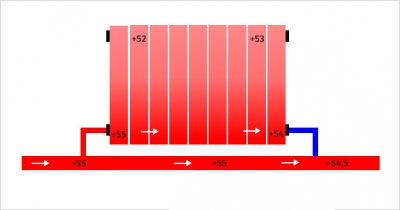
Leningradka contributes to a more uniform heating of the premises.
Each scheme has its own advantages and disadvantages. What are the advantages of the Leningradka scheme?
- More even distribution of heat throughout the house.
- Relatively simple upgrade.
- Possibility to adjust the temperature in individual rooms (as in two-pipe systems).
One-pipe heating is not perfect, therefore the Leningradka scheme allows to compensate for some of its disadvantages. But it has negative traits:
- limited line length - if there are a lot of radiators in the horizontal chain, then there will still be losses;
- the need to use large diameter pipes for a more even heat distribution.
The last drawback can be eliminated by installing a circulation pump in the system.
Features of the installation of "Leningradka"
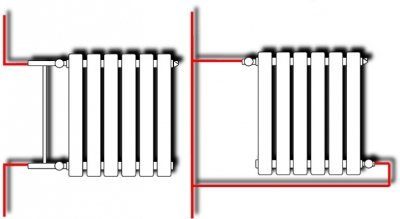
Connection options for "Leningradka" in a single-pipe vertical scheme.
When creating heating systems for private houses with their own hands, many people actively use the Leningradka scheme. How is it laid? To create a circuit, it is necessary to place radiators and lay a pipe under them, from which branches are made to the inputs and outputs of the radiators. That is, a jumper is formed under each radiator. In addition, we can install three taps for each radiator - the first two taps are installed at the inputs and outputs, and the third is installed on the jumper itself. What does it do?
- With the help of taps, you can regulate the temperature in individual rooms.
- Ability to exclude any radiator without shutting down the entire system(for example, if one radiator is dripping and needs to be replaced).
Thus, the "Leningradka" scheme is the optimal scheme for one-story and two-story houses of a small size - you can save on materials and achieve an even distribution of heat throughout the premises.
Bottom piped two-pipe system
Next, we will consider two-pipe systems, characterized in that they provide an even distribution of heat even in the largest households with many rooms. It is the two-pipe system that is used to heat multi-storey buildings, in which there are a lot of apartments and non-residential premises - this scheme works great here. We will consider schemes for private houses.
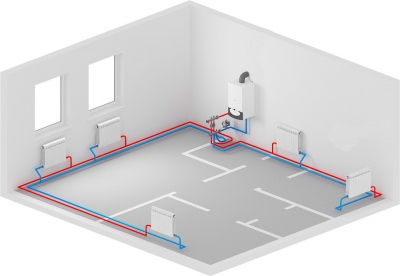
A two-pipe heating system consists of a supply and a return pipe. Radiators are installed between them - the radiator inlet is connected to the supply pipe, and the outlet is connected to the return pipe. What does it do?
- Even distribution of heat throughout the premises.
- Possibility to regulate the temperature in rooms by completely or partially covering individual radiators.
- The possibility of heating multi-storey private houses.
There are two main types of two-pipe systems - with bottom and top wiring. To begin with, we will consider a two-pipe system with a bottom wiring.
Bottom piping is used in many private houses, as it makes the heating less visible. The supply and return pipes run next to each other here, under radiators or even in floors. Air removal is carried out through special Mayevsky taps. Heating schemes in a private house made of polypropylene most often provide for just such a wiring.
Advantages and disadvantages of a two-pipe system with bottom wiring

When installing heating with lower wiring, we can hide the pipes in the floor.
Let's see what are the positive features of two-pipe systems with a bottom wiring.
- Possibility of masking pipes.
- The possibility of using radiators with bottom connection - this somewhat simplifies installation.
- Heat losses are minimized.
The ability to at least partially make the heating less visible attracts many people. In the case of the bottom wiring we get two parallel pipes running flush with the floor... If desired, they can be brought under the floors, providing for this possibility even at the stage of designing a heating system and developing a project for the construction of a private house.
As for the disadvantages, they consist in the need for regular manual air removal and the need to use a circulation pump.
Features of installation of a two-pipe system with bottom wiring
![]()
Plastic fasteners for heating pipes of different diameters.
In order to mount the heating system according to this scheme, it is necessary to lay the supply and return pipes around the house. For these purposes, there are special plastic fasteners on sale. If radiators with side connection are used, we make a branch from the supply pipe to the upper side hole, and we take the coolant through the lower side hole, directing it into the return pipe. We put air drains next to each radiator. The boiler in this scheme is installed at the lowest point.
Such a scheme is most often made closed, using a sealed expansion tank.... The system is pressurized with a circulation pump. If you need to heat a two-story private house, we lay pipes on the upper and lower floors, after which we create a parallel connection of both floors to the heating boiler.
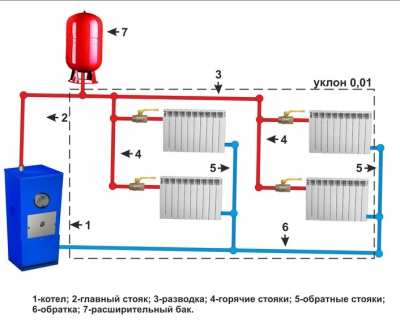
In a two-pipe heating system with top wiring, the expansion vessel is placed at the highest point.
This two-pipe scheme is very similar to the previous one, only it provides for the installation of an expansion tank at the very top of the system, for example, in an insulated attic or under the ceiling. From there, the coolant goes down to the radiators, gives them part of its heat, after which it is sent through the return pipe to the heating boiler.
What is such a scheme for? It is optimal in multi-storey buildings with a large number of radiators. Thanks to this, a more uniform heating is achieved, there is no need to install a large number of air drains - the air will be removed through the expansion tank or through a separate drain that is part of the security group.
Advantages and disadvantages of the top-wired two-pipe system
There are a lot of positive features:
- you can heat multi-storey buildings;
- savings on air drains;
- you can create a system with natural circulation of the coolant.
There are also some disadvantages:
![]()
The use of vertical wiring will lead to additional difficulties in the hidden installation of heating.
- pipes are visible everywhere - such a scheme is not suitable for interiors with expensive finishes, where elements of heating systems are usually hidden;
- in tall buildings, it is necessary to resort to forced circulation of the coolant.
Despite the disadvantages, the scheme remains quite popular and widespread.
Features of installation of two-pipe systems with top wiring
This scheme provides for the absence of the need for the location of the heating boiler at the lowest point. Immediately after the boiler, the supply pipe is led upwards, and an expansion tank is installed at the highest point. The coolant is supplied to the radiators from the top, therefore, a lateral or diagonal radiator connection scheme is used here. After that, the cooled coolant is sent to the return pipe.
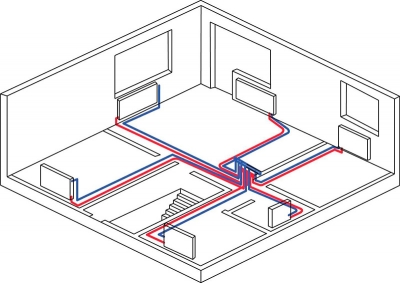
Radiant heating system using a collector.
This is one of the most modern schemes implying the laying of an individual line to each heating device... For this, collectors are installed in the system - one collector is supply, and the other is return. Separate straight pipes diverge from the collectors to the batteries. This scheme allows for flexible adjustment of the parameters of the heating system. It also makes it possible to connect heated floors to the system.
The beam wiring is actively used in modern homes. The supply and return pipes can be laid here as you like - most often they go in the floors, after which they go to one or another heating device. To adjust the temperature and turn on / off heating devices in the house, small distribution cabinets are installed.
According to heating specialists, such a scheme is ideal, since each heating device operates on its own line and almost does not depend on other heating devices.
Advantages and disadvantages of beam systems
There are many positive qualities:
- the ability to completely hide all pipes in walls and floors;
- convenient system configuration;
- the ability to create a remote separate adjustment;
- minimum number of connections - they are grouped in distribution cabinets;
- it is convenient to repair individual elements without interrupting the operation of the entire system;
- almost perfect heat distribution.
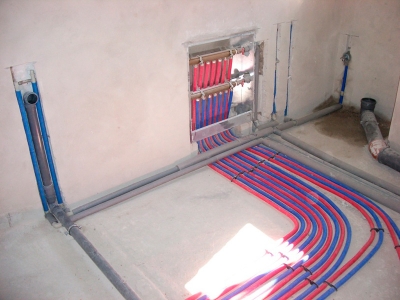
When installing a radiant heating system, all pipes are hidden in the floor, and the collectors are in a special cabinet.
There are also a couple of disadvantages:
- the high cost of the system - this includes the cost of equipment and the cost of installation work;
- difficulty in implementing the scheme in an already built house - usually this scheme is laid down at the stage of creating a home ownership project.
If you still have to put up with the first drawback, then you can't get away from the second.
Features of installation of radiant heating systems
At the stage of project creation, niches for laying heating pipes are provided, points of installation of distribution cabinets are indicated. At a certain stage of construction, pipes are laid, cabinets with collectors are installed, heating devices and boilers are installed, a test run of the system is carried out and its tightness is checked. It is best to entrust all this work to professionals, since this scheme is the most complex.
Despite all the complexity, the radiant heating system with collectors is one of the most convenient and efficient. It is used not only in private houses, but also in other buildings, for example, in offices.
With forced and natural circulation
All the schemes presented above can be created on the basis of heating boilers of any type. For example, the scheme of stove heating of a private house is built on the basis of a wood-burning or coal stove, and piping can be performed according to almost any of the above schemes. True, in many of them it would not hurt to add forced circulation. What is it for?

The main difference between a system with forced circulation of a coolant from a system with a natural one is a circulation pump.
As we remember, one-pipe heating systems are characterized by a decrease in the temperature of the coolant with distance from the boiler - some of the heat remains in the radiators. These losses are partially compensated by the Leningradka scheme, but in some cases even this is not enough. In order to remedy the situation, a circulation pump is installed in the heating system, which provides forced circulation of the coolant.
Forced circulation is also necessary in many other schemes, including two-pipe. The thing is that the small diameter of modern polypropylene pipes, numerous connections and turns create hydraulic resistance. In addition, the use of forced ventilation allows for faster heating of households.
Advantages and disadvantages of forced and natural circulation
Each system has its own advantages and disadvantages:
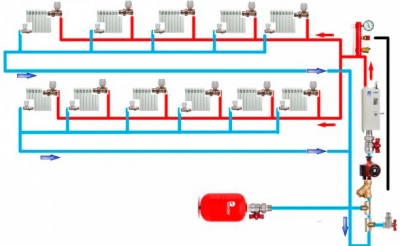
When heating a room with a large number of radiators, a circulation pump is a must.
- natural circulation is easier and cheaper- there are no costs for circulation pumps;
- forced circulation makes it possible to improve the operation of heating in large buildings - in some cases, natural circulation can be dispensed with, but then the heating time of the system increases;
- forced circulation is characterized by a slight hum - natural circulation is completely silent.
That is, everything has its advantages and disadvantages.
Features of installation of systems with forced circulation
Everything is very simple here - the circulation pump is installed next to the heating boiler. It is imperative to create a bypass so that the pump can be excluded from the general scheme or replaced in the event of a breakdown. It is recommended to choose efficient low-noise pumps so that they do not pester with a barely audible, but no less disgusting hum.



